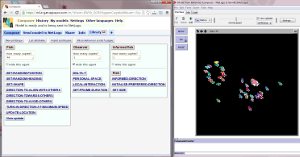Behaviour Composer
|
| |
|
Behaviour Composer model of a school of fish | |
| Original author(s) | Ken Kahn |
|---|---|
| Developer(s) | University of Oxford Modelling4All Project |
| Development status | Active |
| Written in | Java |
| Operating system | Cross-platform: Linux, Mac OS X, Windows |
| Available in | Multilingual |
| Type | Web-based agent-based model development environment |
| License | New BSD License |
| Website |
www |
The Behaviour Composer is a web-based tool for creating and running NetLogo agent-based models.
Overview
The Behaviour Composer was developed at the University of Oxford in England by the Modelling4All Project[1] to enable students and researchers to build agent-based models directly in a browser. Models are composed by combining and customising micro-behaviours. Among the five publications on the Behaviour Composer [2] The Modelling4All Project -- A web-based modelling tool embedded in Web 2.0 [3] is the best overview.
Usage in teaching
The Behaviour Composer has been used in teaching agent-based modelling in general as well as zoology[4][5] and business school[6] courses.
Usage in outreach
A customisation of the Behaviour Composer called the Epidemic Game Maker [7] was exhibited at the Royal Society Summer Science Exhibition. During the ten-day exhibition over one thousand models/games of an epidemic were created by visitors.
An Open Educational Resources model of the Spanish Flu Pandemic was built in the Behaviour Composer.[8]
Usage in research
Researchers have built serious models in archeology, anthropology, political science, economics, epidemics, oncology, fishing, and farming.[9]
Technical details
The Behaviour Composer is an open source Java program.[10] It was built using the Google Web Toolkit and runs on the Google App Engine. Models can be constructed in any modern web browser and run as a Java applet, downloaded to NetLogo, or using the BC2NetLogo tool.[11]
Components of models called micro-behaviours (modular code fragments) can be hosted as pages on any web server. Models are stored on the server and can be accessed and shared via URLs.
References
- ↑ "Welcome to the Modelling4All project". Modelling 4 All. Retrieved 2015-07-27.
- ↑ "Publications - Modelling4All". Resources.modelling4all.org. Retrieved 2015-07-27.
- ↑ Ken Kahn; Howard Noble (August 2010). The Modelling4All Project -- A web-based modelling tool embedded in Web 2.0. Constructionism 2010. Paris, France. Retrieved October 31, 2014.
- ↑ "Modeller". M.modelling4all.org. Retrieved 2015-07-27.
- ↑ "Modeller". M.modelling4all.org. Retrieved 2015-07-27.
- ↑ "Modeller". M.modelling4all.org. Retrieved 2015-07-27.
- ↑ Ken Kahn; Howard Noble; Arthur Hjorth; Fabio Ferrentini Sampaio (August 2012). Three-minute Constructionist Experiences. Constructionism 2012. Athens, Greece. Retrieved October 31, 2014.
- ↑ "The Spanish Flu pandemic model - Modelling4All". Resources.modelling4all.org. Retrieved 2015-07-27.
- ↑ "Agent-based modelling at the University of Oxford | Modelling4All project blog". Blogs.it.ox.ac.uk. 2014-10-23. Retrieved 2015-07-27.
- ↑ "modelling4all - modelling4all project issue tracking and source code repository - Google Project Hosting". Code.google.com. Retrieved 2015-07-27.
- ↑ "Behaviour Composer direct to NetLogo guide - Modelling4All". Resources.modelling4all.org. 2013-01-14. Retrieved 2015-07-27.
